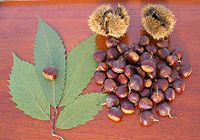
Photo from wikipedia
Traditional medicines (TMs) have made a great contribution to the human healthcare over thousands of years. Therefore, it is of great importance to effectively assess the quality of TMs, which… Click to show full abstract
Traditional medicines (TMs) have made a great contribution to the human healthcare over thousands of years. Therefore, it is of great importance to effectively assess the quality of TMs, which is necessary to ensure their clinical therapeutical effect. With the natural origin, TMs contain a complex chemical composition with numerous unknown components, bringing inevitable difficulties in quality control by chemical approaches (the identification or determination of components). Besides, chemical approaches are insufficient to provide an evidence of the relationship between components and bioactivities. Thus, bioassay, a qualitative or quantitative evaluation of the specific biological effects of tested drugs on biological systems (animals, tissues, organs, microorganisms, and cells, as well as related biological factors, etc.) under specific experimental conditions, is proposed to comprehensively control the quality of TMs. Importantly, the methodology for TM bioassay still needs further development, and some key issues including biochemical principle, experimental system, application scope, and the limitation of bioassays in the quality control of TMs need to be elucidated. Accordingly, this Research Topic serves as a forum to solve the above-mentioned problems by publishing researches on establishing experimental systems, developing novel techniques or data processing models, elucidating mechanisms, or proposing perspectives and so forth, with the purpose of better improvement of the safety and effectiveness of TMs. Given that TMs have apparent characteristics of multiple components and targets, it is essential to use proper approaches matching with the characteristics of TMs in bioassay. Noteworthy, the application of multiomics has contributed greatly to the overall description of the homeostatic intervention by TMs, markedly coincident with the characteristics of TMs that work as a holistic system in the treatment of diseases. Importantly, the multiomics is potent to reflect the integrative characteristics of both pathophysiological status and pharmacological effect, which plays an essential role as a bridge connecting efficacy indicator, syndrome feature, drug action, and biological mechanism. Hence, the strategy based on multiomics has been paid closed attention due to its strong capability to elucidate the mechanism of the action of TMs and find appropriate candidates for bioassay. Following this strategy, Gao et al. conducted a bioassay for the quality control of Lianhua Qingwen capsule, a traditional Chinese medicine formula used in the treatment of influenza A virus infection. As the formula effectively improved influenza-like symptoms in the mice infected with influenza A virus, it also obviously changed the metabolic profiling, as suggested by the metabolomic study. Using serum metabolomics analysis, Edited and reviewed by: Michael Heinrich, University College London, United Kingdom
Journal Title: Frontiers in Pharmacology
Year Published: 2022
Link to full text (if available)
Share on Social Media: Sign Up to like & get
recommendations!